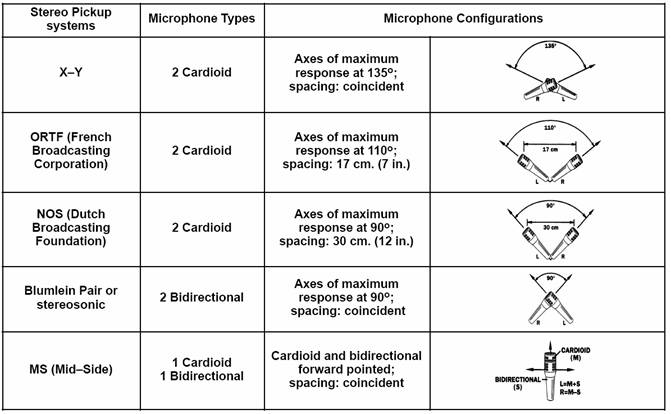Microphones
From Fieldworkguide
Contents |
[edit] Microphones
Of all the technologies mentioned so far microphones tend to evolve the slowest, so it is wise to invest in good microphones as you could be using for years and years. The previously mentioned guide from the Vermont Folklore group has a great section about microphones. Another good resource is Sound Professionals who sell many different microphones and have a helpful staff.
For a more in-depth discussion of microphones for field recording, including comparisons between various models, visit: http://www.transom.org (note, this site is aimed primarily at journalists, but is still helpful).
Ideally, a stereo matched pair are the best microphones for recording live music. Having two separate microphones (one for the right channel and one for the left) can give you a great deal of flexibility by being able to choose different microphone configurations. Here are five popular configurations (for more information, check out: Bruce Bartlett’s “Stereo Microphone Techniques”):
However, fully utilizing the benefits of buying two matched microphones takes time and experience to exploit (there are risks as well; poor microphone placement can result in the two channels being out-of-phase). If you don’t have the time to develop this skill, there are many stereo microphones (they are really two microphones, one for each channel built into one unit) that do a great job.
Quick recommendations:
Stereo Microphones: Rode NT-4 (you can also buy the exact same microphones as separate stereo matched pairs called the NT-5)
A slightly cheaper mic, that is also great is the Audio Technica AT-822 (I believe this is the main stereo microphone available from the UCLA Ethnomusicology Lab). The AT-822 is also light enough that it can be used with many camcorders.
For more, including some exotic microphones, check out http://www.soundprofessionals.com
If you are looking for a good microphone for your camera, the Rode VideoMic is a great option (it is basically a shotgun mic). It only records in mono and its signal response is probably not suited to some kinds of music, but it will make any speech sound much better than the camera’s internal mic. It is also great if you find yourself in a situation where you want the microphone to be much more directional in terms of what it is picking up.
Make sure you also purchase a “shock mount” that fits the microphones you have purchased (most microphones will fit most shock mounts). A shock mount helps to absorb vibrations that can travel up from the ground, tripod or camera that the microphone is resting on. If, for instance, someone bumps a microphone without a shock mount you will hear a very audible bump that could ruin your recording. Shock mounts can be improvised and if nothing else, put a folded up towel under your microphone stand to absorb vibrations from the ground so they don’t travel up to the microphone.
[edit] Techniques
[edit] Equipment Reviews
[edit] Links
- Check out the Audio Section Links from this guide as many of these links also concern microphones.

